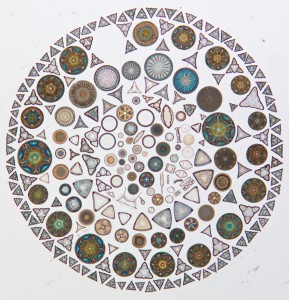搜索结果: 1-15 共查到“海洋科学 on growth”相关记录133条 . 查询时间(0.178 秒)
The 'phytoplankton factory' -- from nutrients to algae growth
phytoplankton ocean ecosystems climate change
2021/8/9
Phytoplankton are the foundation of ocean ecosystems: like rainforests, they consume carbon from the atmosphere, form the basis of the marine food web and have a decisive influence on fish abundance a...
Multiple Sources and Forms of Nitrogen Sustain Year-Round Kelp Growth on the Inner Continental Shelf of the Santa Barbara Channel
Nitrogen Sustain Year-Round Kelp Growth Santa Barbara Channel
2015/7/16
Forests of the giant kelp Macrocystis pyrifera found on coastal rocky reefs lack the large reservoirs for nutrient storage found in many terrestrial environments. Supporting their high year-round grow...

Invisible helpers of the sea: Marine bacteria boost growth of tiny ocean algae(图)
Invisible helpers of the sea Marine bacteria tiny ocean algae
2015/6/18
A glass of seawater is teeming with life, and a recent expedition revealed more about what ocean water contains. Microscopic creatures in the world’s oceans weigh more than all of the fish i...
Iron and copper limitations differently affect growth rates and photosynthetic and physiological parameters of the marine diatom Pseudo-nitzschia delicatissima
Iron and copper limitations differently affect growth rates photosynthetic and physiological parameters marine diatom Pseudo-nitzschia delicatissima
2014/4/2
In ~ 50% of the ocean, iron (Fe) limits phytoplankton growth, including that of the diatom Pseudo-nitzschia. Fe-limited Pseudo-nitzschia spp. may produce the potent neurotoxin domoic acid (DA) to acce...
Increased cellular brevetoxins in the red tide dinoflagellate Karenia brevis under CO2 limitation of growth rate: Evolutionary implications and potential effects on bloom toxicity
Increased cellular brevetoxins Karenia brevis
2014/4/2
Karenia brevis blooms impair human health, marine ecosystems, and coastal economies in the Gulf of Mexico
via their production of carbon-based neurotoxins (brevetoxins), which contain no nitrogen (N)...
Sensitivity of Antarctic phytoplankton species to ocean acidification: Growth, carbon acquisition, and species interaction
Growth carbon acquisition species interaction
2014/4/2
Despite the fact that ocean acidification is considered to be especially pronounced in the Southern Ocean, little
is known about CO2
-dependent physiological processes and the interactions of Antarc...
Many Caribbean coral reefs have either stopped growing or are on the threshold of starting to erode with potential impacts to people, according to research from The University of Queensland (UQ).
Nitrate–nitrite dynamics and phytoplankton growth: Formulation and experimental evaluation of a dynamic model
Nitrate–nitrite dynamics phytoplankton growth Formulation and experimental evaluation dynamic model
2014/4/4
A multi-nutrient quota model was modified to describe the coupled dynamics of nitrate and nitrite utilization for four phytoplankton species, Picochlorum atomus (Butcher) (Chlorophyta), Nannochloropsi...
Nitrate–nitrite dynamics and phytoplankton growth: Formulation and experimental evaluation of a dynamic model
Nitrate–nitrite dynamics phytoplankton growth Formulation experimental evaluation a dynamic model
2014/4/3
A multi-nutrient quota model was modified to describe the coupled dynamics of nitrate and nitrite utilization for four phytoplankton species, Picochlorum atomus(Butcher) (Chlorophyta), Nannochloropsis...
Phytoplankton growth in three rivers: The role of meroplankton and the benthic retention hypothesis
Phytoplankton growth three rivers The role of meroplankton the benthic retention hypothesis
2014/4/8
We analyzed long-term (5–8 yr) hourly time series of chlorophyll (Chl) converted from fluorescence measurements in relation to discharge and light in three medium- to large-size rivers, where plankton...
Temperature- and cholesterol-induced changes in eicosapentaenoic acid limitation of Daphnia magnadetermined by a promising method to estimate growth saturation thresholds
Temperature cholesterol-induced changes in eicosapentaenoic acid limitation Daphnia magnadetermined a promising method estimate growth saturation thresholds
2014/4/8
We present data on eicosapentaenoic acid (EPA)-limited growth responses ofDaphnia magnaunder different temperatures and different dietary cholesterol availabilities to assess how EPA growth saturation...
Unprecedented slow growth and mortality of the rare colonial cyanobacterium, Nostoc zetterstedtii, in oligotrophic lakes
Unprecedented slow growth rare colonial cyanobacterium
2014/4/4
Centimeter-large colonies of Nostoc zetterstedtii from a Swedish oligotrophic lake had the lowest growth and
mortality rates of any studied temperate macrophyte. Annual growth rates at two shallow si...
Comment: Unimodal relationship between phytoplankton-mass–specific growth rate and size: A reply to the comment by Sal and Lo′ pez-Urrutia (2011)
Comment Unimodal relationship phytoplankton-mass–specific growth rate size Sal and Lo′ pez-Urrutia 2011
2014/4/4
Comment: Unimodal relationship between phytoplankton-mass–specific growth rate and size: A reply to the comment by Sal and Lo′ pez-Urrutia (2011)。
Comment: Temperature, nutrients, and the size-scaling of phytoplankton growth in the sea
Comment Temperature nutrients size-scaling of phytoplankton growth the sea
2014/4/4
Comment: Temperature, nutrients, and the size-scaling of phytoplankton growth in the sea。
Interactions between limiting nutrients: Consequences for somatic and population growth of Daphnia magna
Interactions between limiting nutrients population growth of Daphnia magna
2014/4/17
To assess the significance of nutrient interactions on animal performance, life-history experiments were
conducted with the freshwater herbivore Daphnia magna in a system with two limiting nutrients ...

